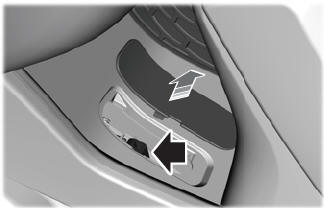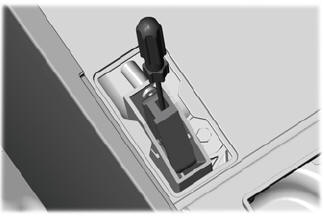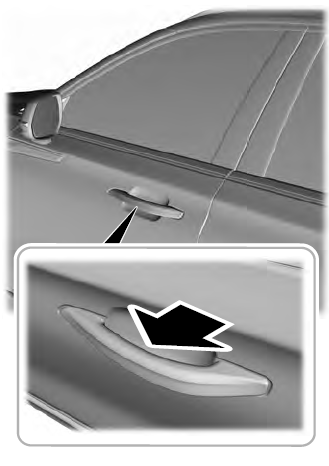Lincoln Aviator 2020-2025 Owners Manual / Transmission / Manual Park Release / Activating the Manual Park Release Cable
Lincoln Aviator: Manual Park Release / Activating the Manual Park Release Cable

- Apply the parking brake.
Note: If vehicle battery is dead, for example, no electrical power is available, you could require an external power source to apply the parking brake.
- Using the key or a flat head screwdriver 4.7 in (120 mm), carefully open the access cover under the arm rest console.
- Turn the vehicle ignition on without starting the vehicle. Press the push to start button without pressing the brake.
- Once in the driver seat, fully apply the brake pedal and hold. Do not release.
- Insert a screwdriver or your car key into
the Manual Park Release lever slot, pull
the Manual Park Release lever toward
the rear until the detent in the slot pops
up against the screwdriver or key. Allow
0.3 in (7 mm) of full upward travel of the
detent, which locks in the park override
mode, and you can remove the
screwdriver or key. If done correctly, a
message on the instrument cluster
displays Park Not Available, Transmission
Not in Park or Shift System Fault.

Note: A screwdriver tool longer than 4.7 in (120 mm) could hit the underside of the armrest console before you achieve full travel of the detent.
- With your foot still fully applied on the brake pedal, disengage the parking brake.
- Your vehicle remains in neutral (N) for emergency towing purposes.
- Switch off the ignition.
- Once it is safe to do so, and there is no risk of your vehicle rolling, disconnect the negative, black, battery cable from the battery.
 Manual Park Release
Manual Park Release
WARNING: When doing this
procedure, you need to take the
transmission out of park (P) which means
your vehicle can roll freely. To avoid
unwanted vehicle movement, always fully
apply the parking brake prior to doing this
procedure...
 Returning Your Vehicle to Normal Mode
Returning Your Vehicle to Normal Mode
Once it is safe to do so, reconnect the
negative, black, battery cable to the
battery.
Apply the parking brake.Note: If the vehicle battery is dead,
you
could require an external power source to
apply the parking brake...
Other information:
Lincoln Aviator 2020-2025 Owners Manual: Traction Control
Principle of Operation The traction control system helps avoid drive wheel spin and loss of traction. If your vehicle begins to slide, the system applies the brakes to individual wheels and, when needed, reduces engine power at the same time. If the wheels spin when accelerating on slippery or loose surfaces, the system reduces engine power in order to increase traction...
Lincoln Aviator 2020-2025 Owners Manual: Adaptive Headlamps
About Adaptive Headlamps The headlamps are designed to adapt when you are steering around a curve, or if the camera detects lane markings indicating a curve or traffic signs indicating an intersection. The system is designed to operate if all of the following occur: You switch the system on through your vehicle settings...
Categories
- Manuals Home
- Lincoln Aviator Owners Manual
- Lincoln Aviator Service Manual
- Fuel Quality
- Garage Door Opener
- Description and Operation - Jacking and Lifting
- New on site
- Most important about car
Activating Intelligent Access
The intelligent access key must be within 3 ft (1 m) of the door or luggage compartment you intend to lock or unlock.
At a Door
Electronic door handles are on each door. Gently depress the switch inside the exterior door handle to unlock and open the door. An unlock symbol illuminates on the door window trim indicating your vehicle is unlocked.

Copyright © 2025 www.liaviator2.com
